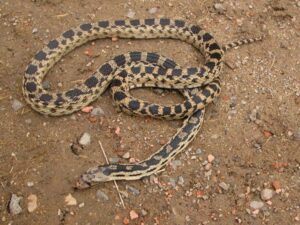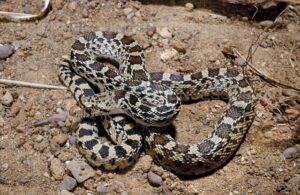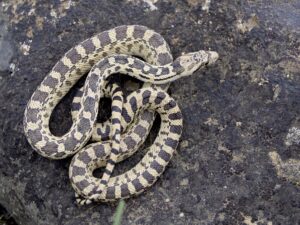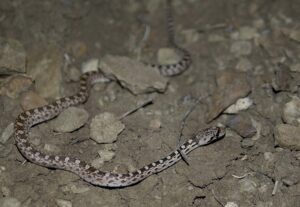Great Basin Gopher Snake (Pituophis catenifer deserticola)
Updated on
25/04/2024The Great Basin gopher snake found in parts of the western United States and adjoining southwestern Canada is a subspecies of the gopher snake. The large, mostly diurnal colubrid is a great swimmer, climber, and burrower that is commonly seen on the road when people and driving or hiking.
Scientific Classifications
- Suborder:Serpentes
- Family:Colubridae
- Genus:Pituophis
- Species:P. catenifer
- Subspecies:P. c. deserticola
Conservation Status
Description
Size
The total length of an adult is usually 4.5 ft (137 cm). The maximum recorded total length is 5.75 ft (175 cm).
Color and Appearance
The snake has dark brown or black dorsal spots that are connected by very thin lines that run along the sides of the front part of the body. The ground color is cream to yellowish. Each side of the neck usually has a dark longitudinal stripe bordered by some lighter coloring that eventually breaks at the rear of the snake, turning into small spots or dashes. The underside is of a creamy color with small, irregular, and dark blotches. Keeled scales cover the body, and the head is of a pointed shape.
Are They Dangerous to Humans
The Great Basin gopher snake is not dangerous unless provoked. When defending itself, it raises and inflates its body and flattens the head into a triangular shape. This is followed by loud hissing sounds and rapid shaking of the tail akin to the sound of the deadly Great Basin rattlesnake. But it is non-venomous.
Great Basin Gopher Snakes at a Glance
Distribution
It lives in the United States in California, Arizona, Colorado, Nevada, Idaho, New Mexico, Utah, Oregon, Wyoming, and Washington, and in Canada in British Columbia.
Habitat
It inhabits woodlands, grasslands, deserts, agricultural lands, coastal sage scrubs, and riparian regions.
Lifespan
The average lifespan of the Great Basin gopher snake is 12-15 years.
Predators
Its predators include kit foxes, coyotes, birds of prey and sometimes, kingsnakes.
Diet
It preys on various animals, including lizards, small mammals (pocket gophers), birds, and their eggs.
Reproduction
Oviparous (lays eggs that hatch outside the body)
The males seek the females for mating in spring, and eggs are laid from June to August. 3-24 eggs form a clutch, with the average being 7 eggs. The hatchlings emerge in late August and September. They measure 12-18 in (30-46 cm) in total length.
Source
i.pinimg.com, sciencesource.com, coloradosnakes.com









